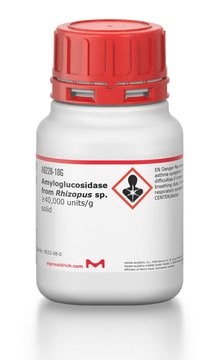U4125
Uridine 5′-(trihydrogen diphosphate) sodium salt from Saccharomyces cerevisiae
95-100%
Sinónimos:
UDP sodium salt, Uridine 5′-(trihydrogen pyrophosphate) sodium salt
About This Item
Productos recomendados
assay
95-100%
solubility
H2O: soluble 100 mg/mL, clear, colorless to very faintly yellow
storage temp.
−20°C
SMILES string
[Na+].[Na+].[Na+].O[C@H]1[C@@H](O)[C@@H](O[C@@H]1COP([O-])(=O)OP([O-])([O-])=O)N2C=CC(=O)NC2=O
InChI
1S/C9H14N2O12P2.3Na/c12-5-1-2-11(9(15)10-5)8-7(14)6(13)4(22-8)3-21-25(19,20)23-24(16,17)18;;;/h1-2,4,6-8,13-14H,3H2,(H,19,20)(H,10,12,15)(H2,16,17,18);;;/q;3*+1/p-3
InChI key
GFASEGWJDXDCKZ-UHFFFAOYSA-K
Gene Information
human ... LPAR4(2846) , LTB4R(1241) , P2RY1(5028) , P2RY10(27334) , P2RY11(5032) , P2RY12(64805) , P2RY13(53829) , P2RY14(9934) , P2RY2(5029) , P2RY4(5030) , P2RY5(10161) , P2RY6(5031) , P2RY8(286530)
Categorías relacionadas
Application
Biochem/physiol Actions
Features and Benefits
Preparation Note
signalword
Warning
hcodes
Hazard Classifications
STOT SE 2
target_organs
Eyes,Central nervous system
Storage Class
11 - Combustible Solids
wgk_germany
WGK 3
flash_point_f
Not applicable
flash_point_c
Not applicable
Certificados de análisis (COA)
Busque Certificados de análisis (COA) introduciendo el número de lote del producto. Los números de lote se encuentran en la etiqueta del producto después de las palabras «Lot» o «Batch»
¿Ya tiene este producto?
Encuentre la documentación para los productos que ha comprado recientemente en la Biblioteca de documentos.
Los clientes también vieron
Protocolos
ZIC®-cHILIC is a densely bonded zwitterionic stationary phase with phosphorylcholine functional groups covalently attached to silica.
HILIC separation is an alternative that permits sensitive MS detection and without the use of ion-pair reagents.
Nuestro equipo de científicos tiene experiencia en todas las áreas de investigación: Ciencias de la vida, Ciencia de los materiales, Síntesis química, Cromatografía, Analítica y muchas otras.
Póngase en contacto con el Servicio técnico














